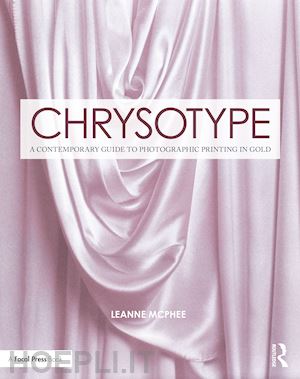Preface Introduction to chrysotype PART ONE: HISTORY Chapter 1, Early experiments with gold and the chrysotype invented and reinvented The ‘Ingenious and Lively’ Elizabeth Fulhame Herschel and iron-based printing in gold Experiments with Gold and Iron Herschel’s chrysotype process Herschel’s chrysotype prints Nanoparticle gold and colour New Chrysotype PART TWO: PREPARATION AND GUIDE TO CHRYSOTYPE Chapter 2, Preparing for printing Safety first Chemical safe handling, storage and disposal Work spaces and lighting General consumables General equipment and materials Equipment and materials for making negatives Analogue film Digital negatives Equipment and materials for coating paper Optional items for coating paper Equipment and materials for controlling humidity (pre and post exposure) Equipment and materials for exposing the print Making a basic contact printing frame Equipment and materials to process and dry prints Optional items for processing and drying prints Equipment to make and store the chemistry for Version ‘S’ Additional items for Versions ‘M’ and ‘P’ Chemicals Chemicals for Version ‘S’ Coating Humidity control Processing Useful measurement conversions Weight Liquids Chapter 3, Preparing the negative Film negatives Film development Creating a large format film negative with PMK developer Working formula PMK Development Process Chemicals Using a transmission step wedge Masking the negative Digital negatives Creating a basic digital negative Chapter 4, Paper choice Paper Types Surface finish HOT/HP NOT or CP Rough Size and weight Paper additives Impact of paper additives on chrysotype Sizing – application and type Internal (‘engine’, ‘body’ or beater) sizing Surface (‘Tub’, ‘External’) sizing Impact of sizing on chrysotype colour Papers for chrysotype Paper handling and storage Paper treatment Decalcifying paper Procedure for removing calcium chloride Sulphamic acid decalcification process Surface-sizing paper with hardened gelatin Gelatin hardening process [INSERT xx.2 HERE] Chapter 5, Overview of the chrysotype process Overview of the steps to create a chrysotype print A quick guide to getting the common chrysotype colours "I want a pink image." "I want a split tone image." "I want a blue image." Chapter 6, Making and mixing the sensitiser. Version ‘S’ – sodium method Chemicals, equipment and materials Preparing stock solutions for Version ‘S’ sensitiser A. Ligand solution (1.4 molar) B. Gold solution (0.35 molar) – Option 1 Sodium Tetrachloroaurate B. Gold solution (0.35 molar) – Option 2 Hydrogen Tetrachloroaurate C. Iron solution (1.4 molar) Tween® 20 Version ‘S’ mixing and contrast controls Contrast control and volume ratios Working out the volume of solution Advanced section New Chrysotype Version ‘M’ Chemicals, equipment and materials Preparing stock solutions for Version ‘M’ sensitiser A. Ligand solution (1.4 molar) Differences in use between Versions ‘M’ and ’S’ New Chryostype Version ’P’ Chemicals, equipment and materials Preparing stock solutions for Version ‘P’ sensitiser A. Ligand solution (1.4 molar) B. Gold solution (0.35 molar) Hydrogen Tetrachloroaurate C. Iron solution (1.4 molar) D Sodium hydroxide solution (14 molar) Version ‘P’ mixing and contrast controls Contrast control and volume ratios Working out the volume of solution Chapter 7, Coating Paper Chemicals, equipment and materials for coating paper Glass coating rod Items for making a glass coating rod Making a glass coating rod Brush coating Coating the paper Which side of the paper to coat? Helpful coating tips Rod coating method Brush coating method Coating translucent ‘vellum’ paper Chapter 8, Regulating Paper Humidity What is relative humidity? The effect of humidity on chrysotype colour Low humidity 9–35 % Intermediate humidity 36–65% High humidity 66–100% How to regulate humidity Timed Air Drying Extended Heat Drying Regulated humidity chamber How to construct a humidity chamber Salt humidity chamber Silica bead humidity chamber Water hydration chamber How to use a humidity chamber Chapter 9, Exposing and Processing the Print Exposing the print Exposure time and print-out Exposure time and ligand to gold ratio Humidity and extent of print-out Hydration after exposure Steaming and print-out Steaming procedure Localised breathing Processing the exposed print Standard developing agents and colour Development characteristics, time and temperature Clearing baths Chemicals, equipment and materials for processing prints Processing procedure Advanced section Testing potential developing agents Colour intensification The salts of the standard developing agents Chapter 10, Troubleshooting chrysotype I can’t get ‘that’ colour again The print looks ‘grainy’ The image highlights are stained red/purple The print has ‘speckles’ in the shadow areas The print has dark ‘measles’ marks The print has white splotches I can’t get an even coating Brush coating Rod coating The sensitiser disappears after one or two coating passes The paper turns yellow or orange after coating My print is too dark The negative looks ‘thin’ Paper Post hydration Developing agent used My print has too much contrast A higher ligand ratio The negative is too dense Choice of developer The image is faint or lacks contrast Parts of the image look ‘blurred’ PART THREE: CONTEMPORARY CHYRSOTYPE ARTISTS Chapter 11, Contemporary chrysotype artists Giorgio Bordin Bianca Conwell Wendy Currie Miguel Duarte Danielle Edwards Mark L Eshbaugh Esme Ann Everingham Aileen Hubbard Tony McLean Pradip Malde Marek Matusz Mike Ware Bibliography Appendices Suppliers Chemical Information












